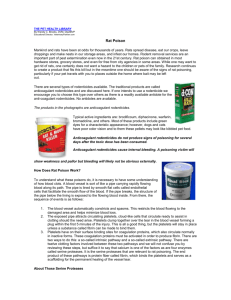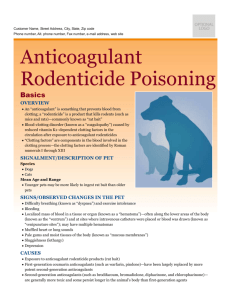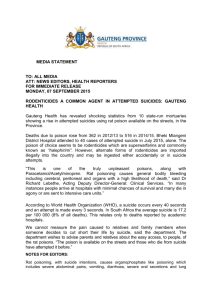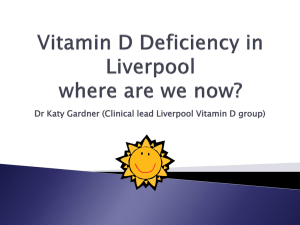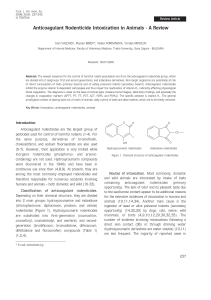Anticoagulant Rodenticides
advertisement
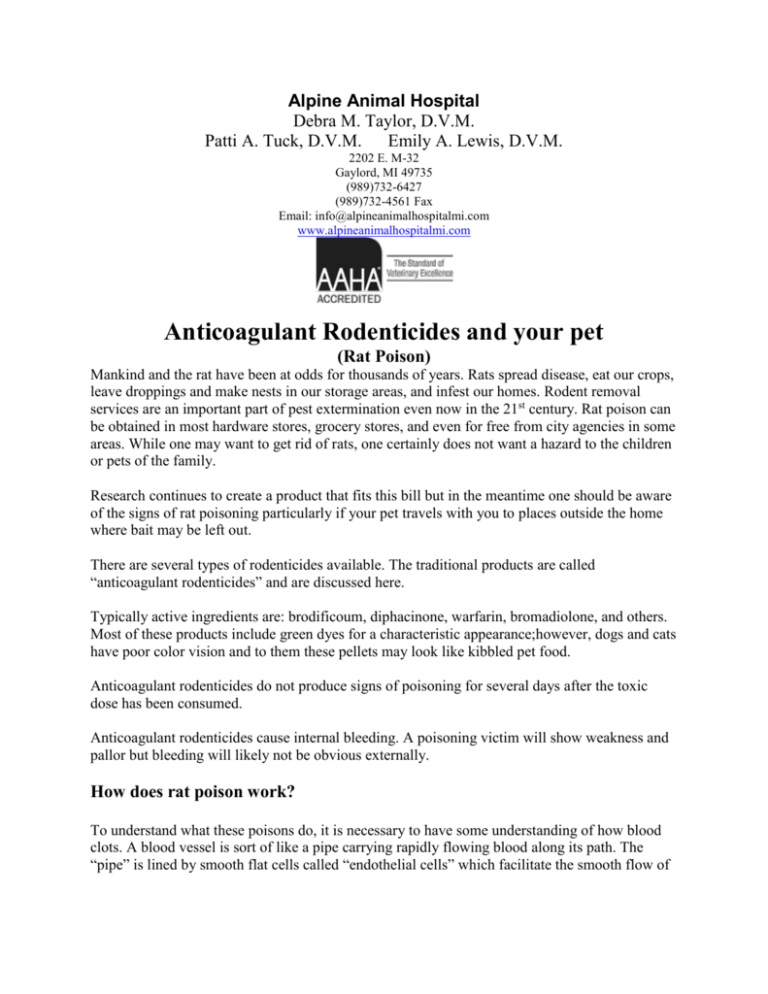
Alpine Animal Hospital Debra M. Taylor, D.V.M. Patti A. Tuck, D.V.M. Emily A. Lewis, D.V.M. 2202 E. M-32 Gaylord, MI 49735 (989)732-6427 (989)732-4561 Fax Email: info@alpineanimalhospitalmi.com www.alpineanimalhospitalmi.com Anticoagulant Rodenticides and your pet (Rat Poison) Mankind and the rat have been at odds for thousands of years. Rats spread disease, eat our crops, leave droppings and make nests in our storage areas, and infest our homes. Rodent removal services are an important part of pest extermination even now in the 21st century. Rat poison can be obtained in most hardware stores, grocery stores, and even for free from city agencies in some areas. While one may want to get rid of rats, one certainly does not want a hazard to the children or pets of the family. Research continues to create a product that fits this bill but in the meantime one should be aware of the signs of rat poisoning particularly if your pet travels with you to places outside the home where bait may be left out. There are several types of rodenticides available. The traditional products are called “anticoagulant rodenticides” and are discussed here. Typically active ingredients are: brodificoum, diphacinone, warfarin, bromadiolone, and others. Most of these products include green dyes for a characteristic appearance;however, dogs and cats have poor color vision and to them these pellets may look like kibbled pet food. Anticoagulant rodenticides do not produce signs of poisoning for several days after the toxic dose has been consumed. Anticoagulant rodenticides cause internal bleeding. A poisoning victim will show weakness and pallor but bleeding will likely not be obvious externally. How does rat poison work? To understand what these poisons do, it is necessary to have some understanding of how blood clots. A blood vessel is sort of like a pipe carrying rapidly flowing blood along its path. The “pipe” is lined by smooth flat cells called “endothelial cells” which facilitate the smooth flow of the blood. If the pipe breaks, the structure of the pipe below the lining is exposed to the flowing blood inside. From there the sequence of events is as follows: 1. The blood vessel automatically constricts and spasms. This restricts the blood flowing to the damaged area and helps minimize blood loss. 2. The exposed “pipe” attracts circulating platelets, cloud-like cells that circulate ready to assist in clotting should the need arise. Platelets clump together over the tear in the blood vessel forming a plug within the first 5 minutes of the injury. This is all a good thing but the platelets will not stay in place unless a substance called “fibrin” can be made to bind them. 3. Platelets have on their surface binding sites for coagulation proteins, which also circulate normally in inactive forms. These coagulation proteins must be activated in order to produce fibrin. There are two ways to do this: a so-called “intrinsic pathway” and a socalled “extrinsic pathway.” There are twelve clotting factors involved between these two pathways and will not confuse you by reviewing these steps but suffice it to say that calcium is one of the factors as are 4 enzymes called “serine proteases.” It is the serine proteases which are relevant to r at poisoning. The end product of these pathways is protein fiber called “fibrin” which binds the platelets and serves as a scaffolding for the permanent healing of the vessel tear. About those Serine Proteases: Clotting factors are identified by number and the serine proteases (also called “Kdependent” factors for reasons which are about to become clear) are factors 2, 7, 9 and 10. These factors are produced in an inactive state by the liver and go happily circulating through the bloodstream awaiting activation. When a vessel tears and it becomes necessary to form a clot, these factors are activated in a process that requires Vitamin K (a fat soluble vitamin not as famous as its fat-soluble cousins Vitamins A and E). As the clotting factors are activated, Vitamin K is inactivated but later recycled by another set of enzymes to be ready to participate in clotting factor activation again later. As long as there is plenty of Vitamin k, the serine proteases can be activated and clotting can proceed normally. The anticoagulant rodenticides abolish Vitamin K recycling. This means that as soon as one’s active Vitamin k reserves are depleted, there can be no meaningful blood clotting. In cases of poisoning one would expect symptoms to be nearly immediate but in the case of anticoagulant rodenticide poisoning, it takes several days to deplete Vitamin K. After that, even the smallest of jostles and traumas can lead to life-threatening bleeds. Symptoms Most of the time external bleeding is not obvious and one only notices the pet is weak and/or cold. If one looks at the gums, they are pale. Sometimes bloody urine or stool is evident or nosebleeds may be seen. Signs of bleeding in more than one body location are a good hint that there is a problem with blood coagulation and appropriate testing and treatment can be started. Therapy If the patient has only just ingested the poison, he or she may be made to vomit it up. Cathartics and adsorbents can be used to prevent the poison from entering the patient’s system. Still, it is prudent to use the antidote anyway. Certainly, if there is evidence that the patient is bleeding, the antidote obviously is required. The antidote is simply Vitamin K. Vitamin k is generally started as an injection and when the patient is stable, tablets are prescribed. Blood transfusions may be needed to stabilize a patient who has suffered significant blood loss. There are different classes of anticoagulant rodenticides and they remain in the body for several weeks. It is important to return for coagulation testing after the entire course of Vitamin K has been given.
